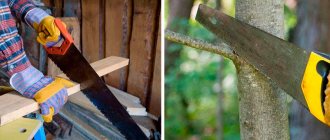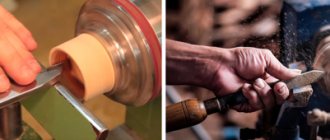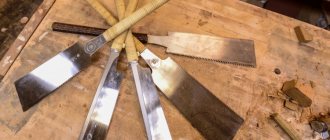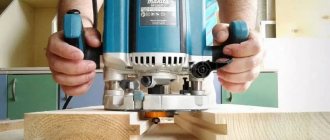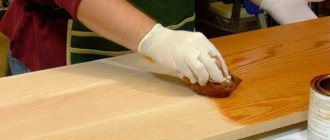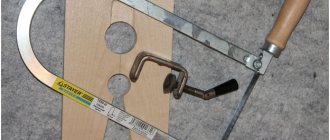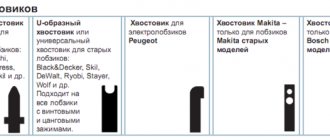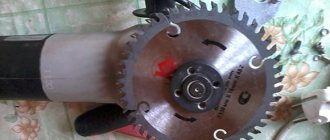A hand saw allows you to quickly, inexpensively and safely cut suitable material during construction, repair and other carpentry work. However, for wood processing to be truly effective, it is necessary to choose the right parameters. Let's look at what are the main criteria for choosing it, what are the main varieties of wood hacksaws, and which of the best available models is in demand among the modern consumer.
Standard hacksaw for wood Source stroy-podskazka.ru
Criterias of choice
The main purpose of a hand saw is longitudinal or cross cutting of wood, as well as materials based on it or similar in properties. When choosing a tool, the following series of parameters are primarily taken into account:
- Purpose.
- Teeth parameters.
- Blade steel type.
- Length and geometry of the canvas.
- Handle shape.
Let us analyze in detail the features of choice for each of them.
Purpose
The first thing you need to know in order to choose the right hacksaw for wood is the type of work performed with it. At the same time, they are classified according to two criteria - type of cut and purpose. According to the nature of the cut, hand saws are divided into 3 main types:
- Longitudinal. They are equipped with teeth with a sharpening angle of about 45-60 degrees. Provides a unidirectional, uniform, precise cut. Therefore, they are used for finishing, in the manufacture of furniture and interior items.
- Transverse. They are characterized by a tooth sharpening angle of the order of 45-55 degrees. Used for cutting in both directions, mainly on dry material.
Cross cutting of a wooden blank Source domnomore.com
- Universal. The blade has two types of teeth - semicircular and triangular. The first ones set the direction of movement, the second ones expand the seam. The closer the teeth are located to each other, the higher the cutting accuracy.
According to their purpose, hand saws are classified into classic, tenon and circular saws. The former are used as a standard, the latter - for the formation of technological tongue-and-groove joints, the latter - for creating rounded shapes and holes.
Teeth parameters
The second important criterion when choosing a saw is the parameters of the teeth. This is primarily their size, which is also directly related to the distance between their tips - the pitch. There are three main groups:
- Small ones. The tooth size is 2-2.5 mm. In this case, the number of teeth (TPI index) for a given length (usually an inch) is 7-9. Used for high-quality precision cutting.
- Average. The teeth are 3-3.5 mm in size. The TPI indicator is 5-7. Used in carpentry work.
- Large ones. The dimensions of the teeth reach 4-6 mm. TPI – 3-5. A wood hacksaw with a large tooth is used for rough work - cutting firewood, building materials - when high speed is required.
Hand saw for wood with large teeth Source domnomore.com
On a note! Modern models of hand saws have a cutting part structure in which teeth alternate with voids. This makes it possible to use the tool on both dry and wet wood. When cutting fresh wood, wet sawdust can be easily removed through the gaps. Thanks to this, the saw does not get stuck and gets the job done quickly.
Blade steel type
Despite the fact that the wood saw is used in mild conditions, its blade is still made of high-quality steel alloys. These are mainly brands such as - 8ХФ, 65Г, У7 - У10, etc. Their main feature is wear resistance, achieved by the inclusion of silicon and carbon in the composition.
However, in order to save money, some manufacturers make blades from ordinary steel and make the cutting part high-strength. Moreover, if the teeth have a hardened structure, which is usually reflected in their characteristic black color, then after inevitable wear they cannot be repaired. At the same time, analogues made of non-hardened steel can be periodically undermined as they wear out.
Sharpening the cutting part of a hand saw for wood Source domnomore.com
See also: Catalog of companies that specialize in finishing materials and related work
Length and geometry of the canvas
In order to choose the right wood hacksaw for optimal and fast sawing in accordance with specific application conditions, it is necessary to take into account the length of the blade. This parameter, as a rule, has a direct relationship with the characteristics of the pitch and size of the teeth, and divides saws into 3 main categories:
- Narrow canvas 250-350 mm long. Equipped with small, frequently spaced teeth.
- Universal saw with a blade of 350-550 mm. Has medium sized teeth.
- Wide canvas with a length of 550-650 mm. equipped with large teeth with increased pitch.
The geometry of the canvas can also vary depending on the purpose. Thus, standard saws have the shape of a beveled rectangle. Special models are equipped with a curved canvas. For example, a branch cutter has the shape of a curved saber, which makes it easy and convenient to work with when trimming garden trees and shrubs.
To trim branches of garden trees, it is convenient to use a specially shaped saw Source domnomore.com
Important! When choosing a saw for specific application conditions, the ratio of the length of the blade and the thickness of the workpiece is not the least important. It should be at least 2 times larger. Otherwise, it will be inconvenient for her to saw: the amplitude of the cut will be insufficient, and the blade will constantly jam.
Handle shape
The shape and size of the handle can have a wide variety of variations - this depends on the type of work being carried out, conditions, anthropometry and user requirements. The main thing is that it is comfortable, fits ergonomically in your hand and does not slip.
Recommendation! For thrifty owners, when equipping a home workshop, the best option for a wood hacksaw would be a model with removable blades. It takes up less storage space and ultimately costs much less than a whole set of hand saws for each application.
Non-standard types of hacksaws for metal
Diamond wire can be used to cut hard alloys, ceramics, stone, concrete and metal. The element is made of alloy steel, onto which a 2 mm layer of diamond coating is applied. At the ends of the string there are loops, which are intended for securing the product to the hacksaw frame.
Diamond thread is capable of cutting a workpiece efficiently, quickly and without much effort. Its work can be compared to a professional version of a hacksaw for metal. However, the cost of diamond string is much lower. The thread makes a cut of a solid workpiece with a depth of 1 mm in 1 minute. A glass product 0.5 cm thick will be cut in 40 seconds. A diamond string can cut a stone in 30 seconds with a cutting depth of 1 cm.
Important! For high-quality and convenient cutting of workpieces, the thread and material should be moistened before starting work, repeating the procedure during the process.
Another blade option for a hacksaw for metal, the price of which is much higher, is a steel thread. Its surface is coated with tungsten carbide. Products are produced in lengths of 300 mm and diameters of 2.7 mm. This thread is capable of performing high-quality, accurate and neat cutting of the workpiece. With its help you can make a curved or circular cut.
Hand hacksaws for metal can have not only a different cutting element, but also the very shape of the product
Varieties
There are the following main types of hand saws for wood:
- Classic. Characterized by a standard design of the canvas. Can have any number of teeth. It is used for a wide range of works - construction, carpentry and carpentry, in everyday life.
The most common type of hand saw for wood Source mosoblzhilservis.rf
- Narrow. It has a characteristic narrow blade, sometimes with double-sided teeth. Used for cutting out holes and contours of complex shapes.
- With a butt. The design of the blade has an additional stiffening rib - on the edge opposite the cutting part. Thanks to it, the saw does not bend under heavy load. A characteristic feature is that the cutting depth is limited by the width of the working part of the blade.
- Luchkovaya. The base uses a thin canvas, secured at the edges with a bow-shaped handle. Pros - the ability to carry out a number of complex works, the complexity of which corresponds to processing on machines. Disadvantages: inconvenience of use, fragility, large dimensions.
- Reward. Saw – with the characteristic profile of a hand plane. The main purpose is to cut out the elements of the tongue-and-groove connection.
- Foldable. A small-sized saw, the cutting part of which, when folded, is placed in the groove of the handle. It is used in hiking, tourism and other field conditions.
Mini folding hacksaws Source domnomore.com
Reference! There are also other, specific types of wood saws with a narrow profile purpose. Prominent among them are a garden saw with reverse teeth for conveniently cutting branches, a two-handed saw for quickly sawing logs, and a compact chain model for tourism.
What is a reciprocating saw and how to choose one
Now let's figure out how to choose an electric hacksaw for wood; in the language of professionals, such a tool is called a reciprocating saw. Compared to hand tools, the selection criteria are slightly different. So, in addition to the reciprocating motion, the reciprocating saw also has a pendulum stroke.
For pruning trees with a reciprocating saw, the tool has a pendulum operating mode.
Vibrations of the blade based on the pendulum principle allow you to work much more efficiently, for example, when pruning trees or other rough work. And the standard mode is good for unraveling sheets of different densities.
In this case, the question of which hacksaw is better for wood will not be entirely correct, because in reciprocating saws the effectiveness of the tool depends on the correct choice of blade. There are blades designed for working on wood, metal, stone, drywall, etc.
Each reciprocating saw blade is designed to work with a specific material.
But the choice of a reciprocating saw does not end only with the purchase of a high-quality blade for the appropriate material; there are also a number of subtleties:
- I, like most craftsmen in this field, believe that buying an electric hacksaw with a power of up to 600 W is simply a waste of money. With it you can cut branches up to 20 mm in diameter and no more. From 600 W to 1 kW is suitable for a variety of country work, and a tool with a power of 1.2 kW is already classified as semi-professional and can effectively cut any materials;
- It is advisable to choose a model where a special key is not needed to change the blade;
- It is better to take a tool with a cutting depth limiter, which, by the way, can also be adjusted with a key or without a key; accordingly, the second type of hacksaw is more convenient;
- Pay attention to the head that holds the blade. There are universal models into which any blade can be inserted, while there are heads “sharpened” only for branded blades from a given manufacturer. It’s not a fact that the store will have the right model of branded canvas, so take a station wagon;
- Theoretically, all reciprocating saws have the ability to disable the pendulum stroke, but when purchasing, it is advisable to check how adequately this option works;
- A reciprocating saw with a speed regulator will significantly expand your work capabilities, and it is desirable that this regulator has a fine-tuning function;
- Another useful function is the ability to rotate the blade at different angles; this option is especially useful when working on the ceiling and in hard-to-reach, tight spaces;
A reciprocating saw with a battery, compared to corded models, has less power, but it is more convenient to use.
TOP best models
The TOP 5 modern hand saws for wood are represented by the following models:
- Bahco 2600-16-XT11-HP. The saw copes equally effectively with transverse and longitudinal cuts. The canvas has a special coating against friction forces. Equipped with resistant teeth and an ergonomic non-slip handle. Weighs less than 0.5 kg. The only negative is the high price.
Hand saw for wood Bahco line Source insales.ru
Video description
Video on how to choose the right hacksaw for wood:
- Stanley Jetcut 2-15-283. This hand saw model was included in the rating of hacksaws for wood as the best among universal ones. Thanks to the 3-sided sharpening of the teeth and a fairly long blade - 45 cm - the tool allows you to saw almost any workpiece without clamping. Disadvantage: the cut is not of very high quality and is not suitable for processing finishing parts.
- BAHCO LAPLANDER 396-LAP. Folding universal saw. Application – construction, tourism, hunting, fishing, gardening. The universal shape of the teeth allows you to cut wood both lengthwise and crosswise. Canvas length 23 cm.
Note! When choosing a saw, it matters how often it will be used. For periodic use, a model with hardened teeth is suitable; for frequent use, it is better to use one made of standard steel, since inevitable grinding will require constant updating of the cutting part, which cannot be done with an analogue made of hardened material.
How to choose your instrument: selection options
The main indicators of the instruments are:
- Canvas length . To perform precise work, small tools with a working base of about 30 cm are used. More productive and efficient results can be obtained by using a hacksaw with a blade of 45-55 cm. In this case, the path of the working edge along the workpiece increases, increasing the cutting speed;
- Web width . This indicator demonstrates the stability of the saw when performing precise work. The wide base allows for more precise control of the vertical, which ensures a clean and straight cut;
- size and type of tooth sharpening. The size of the teeth is determined by the degree of cleanliness of the cut - the more precise it is, the smaller the size and distance between the elements of the notch. The sharpening method allows you to obtain a blade designed for longitudinal sawing (triangular teeth with apexes directed forward), cross-cut (notch in the shape of an isosceles triangle), and a universal type (triangular apexes are slightly ground off for softer contact with the part);
- Wiring . To reduce friction and heating of the blade, the tops of the teeth are alternately deflected from the plane by a certain amount. Modern tools immediately go on sale fully prepared for work, but on old hacksaws the wiring has to be updated as the notches are ground down. If there are carbide brazings, wiring is not required, since their thickness is greater than that of the blade;
- The grade of metal from which the tool is made . The stronger and stiffer the canvas, the more freely the master works with it. Increases productivity and quality of sawing;
- Type and angle of inclination of the handle in relation to the cutting edge . This indicator refers to the organoleptic properties of the instrument. A comfortable handle, installed at the correct angle to the working edge, allows the worker to more confidently control the direction and quality of cutting the material, spend less effort and get a more effective result;
- Saw blade material . The harder the metal, the fewer problems with the cleanliness and accuracy of the cut. Steel from 45 HRC is considered the norm, but harder grades 55-60 HRC can provide increased operational reliability. Some hacksaws have an additional Teflon layer, which eliminates friction and heating of the blade during operation.
Some indicators can be perceived subjectively - it may be more convenient for users to work with a non-standard tool, this is normal, for each master the blade can be slightly modified (the sharpening is changed, the handle is rotated, etc.).
Briefly about the main thing
A hand saw allows you to efficiently, quickly and safely saw wood, as well as materials based on it and analogues with similar characteristics. When choosing a tool, the following parameters are taken into account:
- Purpose.
- Size, pitch, type of teeth.
- Type of fabric material.
- Length and shape of the canvas.
- Type of handle.
There are the following types of saws for wood: classic, narrow, with a back, bow, award, folding. The TOP 5 best models included: Bahco 2600-16-XT11-HP, Gross Piranha 24109, BISON EXPERT, Stanley Jetcut 2-15-283 and BAHCO LAPLANDER 396-LAP.
